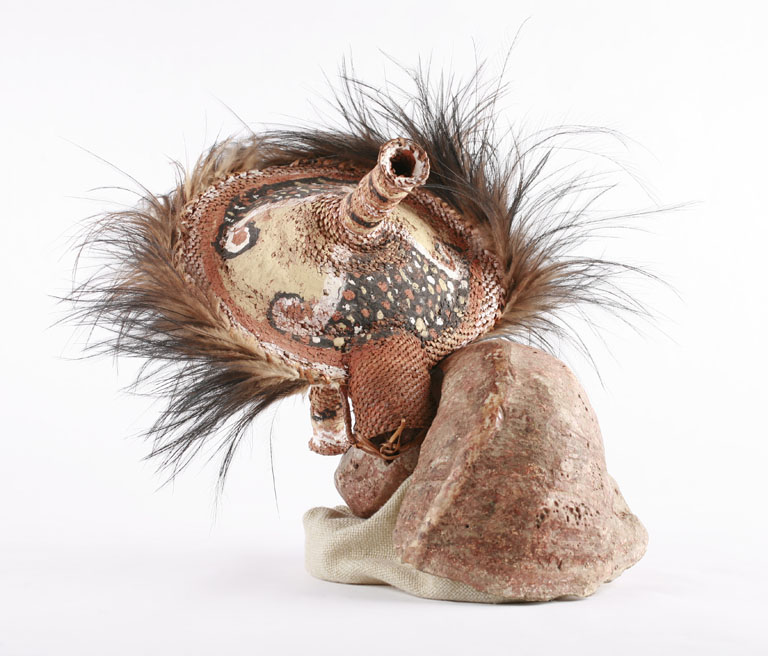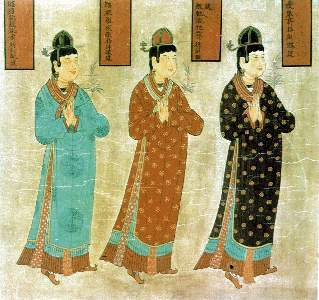|
Emperor Taizong's Campaign Against Tuyuhun
Emperor Taizong of Tang (r. 626-649), the second emperor of the Tang dynasty faced challenges throughout his reign from Tang's western neighbor, the state of Tuyuhun, whose Busabuo Khan Murong Fuyun constantly challenged Tang authority in the border regions. In 634, Emperor Taizong launched a major attack, commanded by the major general Li Jing, against Tuyuhun, dealing Tuyuhun forces heavy defeats and causing Murong Fuyun's subordinates to assassinate him in 635. Tuyuhun, thus weakened, no longer remained a major power in the region, and while Tang, ironically, played the role of protector for Murong Fuyun's son, the Gandou Khan Murong Shun, and grandson, the Ledou Khan Murong Nuohebo, Tuyuhun was never able to recover, particularly with its southwestern neighbor, the Tibetan Empire, constantly attacking it. By 672, during the reign of Emperor Taizong's son Emperor Gaozong of Tang, Tang was forced to move Tuyuhun remnants into its own territory, ending Tuyuhun. During Murong F ... [...More Info...] [...Related Items...] OR: [Wikipedia] [Google] [Baidu] |
Qinghai
Qinghai (; alternately romanized as Tsinghai, Ch'inghai), also known as Kokonor, is a landlocked province in the northwest of the People's Republic of China. It is the fourth largest province of China by area and has the third smallest population. Its capital and largest city is Xining. Qinghai borders Gansu on the northeast, Xinjiang on the northwest, Sichuan on the southeast and the Tibet Autonomous Region on the southwest. Qinghai province was established in 1928 during the period of the Republic of China, and until 1949 was ruled by Chinese Muslim warlords known as the Ma clique. The Chinese name "Qinghai" is after Qinghai Lake, the largest lake in China. The lake is known as Tso ngon in Tibetan, and as Kokonor Lake in English, derived from the Mongol Oirat name for Qinghai Lake. Both Tso ngon and Kokonor are names found in historic documents to describe the region.Gangchen Khishong, 2001. ''Tibet and Manchu: An Assessment of Tibet-Manchu Relations in Five Phases ... [...More Info...] [...Related Items...] OR: [Wikipedia] [Google] [Baidu] |
Gansu
Gansu (, ; alternately romanized as Kansu) is a province in Northwest China. Its capital and largest city is Lanzhou, in the southeast part of the province. The seventh-largest administrative district by area at , Gansu lies between the Tibetan and Loess plateaus and borders Mongolia (Govi-Altai Province), Inner Mongolia and Ningxia to the north, Xinjiang and Qinghai to the west, Sichuan to the south and Shaanxi to the east. The Yellow River passes through the southern part of the province. Part of Gansu's territory is located in the Gobi Desert. The Qilian mountains are located in the south of the Province. Gansu has a population of 26 million, ranking 22nd in China. Its population is mostly Han, along with Hui, Dongxiang and Tibetan minorities. The most common language is Mandarin. Gansu is among the poorest administrative divisions in China, ranking 31st, last place, in GDP per capita as of 2019. The State of Qin originated in what is now southeastern ... [...More Info...] [...Related Items...] OR: [Wikipedia] [Google] [Baidu] |
Qinghai Lake
Qinghai Lake or Ch'inghai Lake, also known by #Names, other names, is the list of lakes by area, largest lakes of China, lake in China. Located in an endorheic basin in Qinghai Province, to which it gave its name, Qinghai Lake is classified as an alkaline lake, alkaline saline lake, salt lake. The lake has fluctuated in size, shrinking over much of the 20th century but increasing since 2004. It had a surface area of , an average depth of , and a maximum depth of in 2008. Names Qinghai is the romanization of Chinese, romanized Standard Chinese pinyin pronunciation of the name Although modern Chinese distinguishes between the colors blue and green, Blue–green distinction in language, this distinction did not exist in classical Chinese. The color (''qīng'') was Blue–green distinction in language#Chinese, a "single" color inclusive of both blue and green as separate shades. (English for ''qīng'' is cyan or turquoise, also linguists have coined the portmanteau "grue" to ... [...More Info...] [...Related Items...] OR: [Wikipedia] [Google] [Baidu] |
Bride Price
Bride price, bride-dowry ( Mahr in Islam), bride-wealth, or bride token, is money, property Property is a system of rights that gives people legal control of valuable things, and also refers to the valuable things themselves. Depending on the nature of the property, an owner of property may have the right to consume, alter, share, r ..., or other form of wealth paid by a groom or his family to the woman or the family of the woman he will be married to or is just about to marry. Bride dowry is equivalent to dowry paid to the groom in some cultures, or used by the bride to help establish the new household, and dower, which is property settled on the bride herself by the groom at the time of marriage. Some cultures may practice both simultaneously. Many cultures practiced bride dowry prior to existing records. The tradition of giving bride dowry is practised in many Asia, Asian countries, the Middle East, Africa, parts of Africa and in Oceania, some Pacific Island societi ... [...More Info...] [...Related Items...] OR: [Wikipedia] [Google] [Baidu] |
Songtsen Gampo
Songtsen Gampo (; 569–649? 650), also Songzan Ganbu (), was the 33rd Tibetan king and founder of the Tibetan Empire, and is traditionally credited with the introduction of Buddhism to Tibet, influenced by his Nepali consort Bhrikuti, of Nepal's Licchavi dynasty, as well as with the unification of what had previously been several Tibetan kingdoms. He is also regarded as responsible for the creation of the Tibetan script and therefore the establishment of Classical Tibetan, the language spoken in his region at the time, as the literary language of Tibet. His mother, the queen, is identified as Driza Thökar (). The date of his birth and of when he took the throne are not certain. In Tibetan accounts, it is generally accepted that he was born in an Ox year of the Tibetan calendar, which means one of the following dates: 557, 569, 581, 593, 605 or 617 CE. He is thought to have ascended the throne at age thirteen (twelve by Western reckoning), by this reckoning c. 629. There are ... [...More Info...] [...Related Items...] OR: [Wikipedia] [Google] [Baidu] |
Crown Prince
A crown prince or hereditary prince is the heir apparent to the throne in a royal or imperial monarchy. The female form of the title is crown princess, which may refer either to an heiress apparent or, especially in earlier times, to the wife of the person styled crown prince. ''Crown prince'' as a descriptive term has been used throughout history for the prince who is first-in-line to a throne and is expected to succeed (i.e. the heir apparent), barring any unforeseen future event preventing this. In certain monarchies, a more specific substantive title may be accorded and become associated with the position of ''heir apparent'' (e.g. Prince of Wales in the United Kingdom or Prince of Asturias in the Spain, Kingdom of Spain). In these monarchies, the term crown prince may be used less often than the substantive title (or never). Until the late twentieth century, no modern monarchy adopted a system whereby females would be guaranteed to succeed to the throne (i.e. absolute pr ... [...More Info...] [...Related Items...] OR: [Wikipedia] [Google] [Baidu] |
Sui Dynasty
The Sui dynasty (, ) was a short-lived imperial dynasty of China that lasted from 581 to 618. The Sui unified the Northern and Southern dynasties, thus ending the long period of division following the fall of the Western Jin dynasty, and laying the foundations for the much longer lasting Tang dynasty. Founded by Emperor Wen of Sui, the Sui dynasty capital was Chang'an (which was renamed Daxing, modern Xi'an, Shaanxi) from 581–605 and later Luoyang (605–18). Emperors Wen and his successor Yang undertook various centralized reforms, most notably the equal-field system, intended to reduce economic inequality and improve agricultural productivity; the institution of the Five Departments and Six Board (五省六曹 or 五省六部) system, which is a predecessor of Three Departments and Six Ministries system; and the standardization and re-unification of the coinage. They also spread and encouraged Buddhism throughout the empire. By the middle of the dynasty, the ... [...More Info...] [...Related Items...] OR: [Wikipedia] [Google] [Baidu] |
Wuwei, Gansu
Wuwei () is a prefecture-level city in northwest central Gansu province. In the north it borders Inner Mongolia, in the southwest, Qinghai. Its central location between three western capitals, Lanzhou, Xining, and Yinchuan makes it an important business and transportation hub for the area. Because of its position along the Hexi Corridor, historically the only route from central China to western China and the rest of Central Asia, many major railroads and national highways pass through Wuwei. History In ancient times, Wuwei was called Liangzhou (—the name retained by today's Wuwei's central urban district) and is the eastern terminus of the Hexi Corridor. People began settling here about 5,000 years ago. It was a key link for the Northern Silk Road, and a number of important archaeological finds were uncovered from Wuwei, including ancient copper carts with stone animals. The motifs and types of objects in the Wuwei graves, as well as their earthenware, lacquer, and bro ... [...More Info...] [...Related Items...] OR: [Wikipedia] [Google] [Baidu] |
Dangxiang
The Tangut people ( Tangut: , ''mjɨ nja̱'' or , ''mji dzjwo''; ; ; mn, Тангуд) were a Tibeto-Burman tribal union that founded and inhabited the Western Xia dynasty. The group initially lived under Tuyuhun authority, but later submitted to the Tang dynasty, prior to their establishment of the Western Xia. They spoke the Tangut language, which was previously believed to be one of the Qiangic languages or Yi languages that belong to the Tibeto-Burman family. Phylogenetic and historical linguistic accounts, however, reveal that Tangut belonged to the Gyalrongic languages. Language The Tangut language, otherwise known as ''Fan'', belongs to the Tibeto-Burman branch of the Sino-Tibetan language family. Like many other Sino-Tibetan languages, it is a tonal language with predominantly mono-syllabic roots, but it shares certain grammatical traits central to the Tibeto-Burman branch. It is still debated as to whether Tangut belongs to the Yi or Qiangic subdivision of ... [...More Info...] [...Related Items...] OR: [Wikipedia] [Google] [Baidu] |
Haidong Prefecture
Haidong (; Wylie: Haitung) is a prefecture-level city of Qinghai province in Western China. Its name literally means "east of the (Qinghai) Lake." On 8 February 2013 Haidong was upgraded from a prefecture () into a prefecture-level city. Haidong is the third most populous administrative division in Qinghai after Xining and Golmud. Haidong was historically populated by the Qiang people, although the area has been inhabited as early as 6000 years ago. In 121 BC the area was captured by Huo Qubing, defeating the Xiongnu. In 399 AD the Xianbei founded the state of Nanliang, with its capital in Ledu District. Geography Haidong is the easternmost division of Qinghai province. It is bounded by Xining, the provincial capital, to the West, the Datong River Valley to the north, Gansu to the east, and the Yellow River to the south. Mountain ranges tower above the district of which the main valley is the one of the Huang Shui (Tib. ''Tsong Chu''), a major tributary of the Yellow River. ... [...More Info...] [...Related Items...] OR: [Wikipedia] [Google] [Baidu] |



